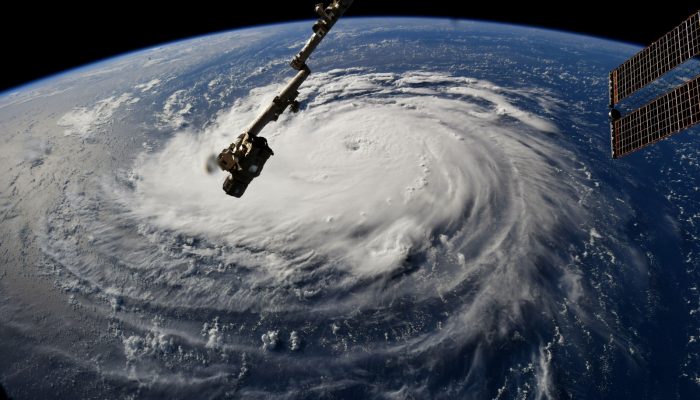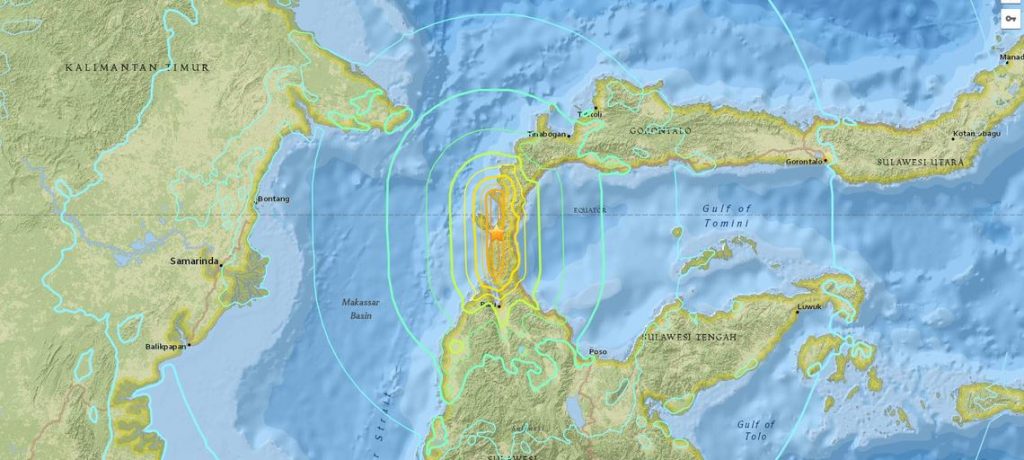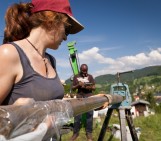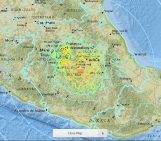
Drawing inspiration from popular stories on our social media channels, major geoscience headlines, as well as unique and quirky research, this monthly column aims to bring you the latest Earth and planetary science news from around the web.
Major stories
This month has been a whirlwind of Earth and space science news; the majority focusing on natural hazards. Powerful cyclones, earthquakes, and tsunamis have received significant coverage from the geoscience media. Quickly recap on an action-packed month with our overview:
On 14 September, Hurricane Florence, made landfall in the mid-Atlantic region of the United States, making first contact near Wrightsville Beach in North Carolina then traveling up the East Coast. By the time Florence had reached the US coastline, the cyclone’s sustained wind speed had dropped considerably, downgrading the hurricane from a category 4 to category 1 storm on the Saffir–Simpson scale.
This designation may sound mild, but as many scientists and journalists have pointed out, sluggish hurricanes are especially dangerous, since they are more likely to dump heavy rainfall over a relatively small surface area compared to faster storms that distribute their rainfall over more territory. This proved to be true for Hurricane Harvey, which dumped more than 150 centimetres of rain onto some areas of Houston, Texas.
Hurricane Florence’s record-breaking rainfall forced more than a million people to evacuate their homes, and experts estimate that the storm inflicted damages worth more than $38 billion (USD). The hurricane also produced very concerning environmental damages. In Wilmington, North Carolina, for instance, the the rainfall flooded a pit of coal ash at a power plant, releasing more than 1,530 cubic metres of ash, with much of it likely ending up in a nearby lake.
Across the planet, just one day following Hurricane Florence’s landfall, Super Typhoon Mangkhut wreaked havoc on southeast Asia, pounding the Mariana Islands, the Philippines, China, Taiwan, and Vietnam with strong wind and rain. Reaching wind speed over 240 kilometres per hour, Mangkhut is the most intense storm of the year so far. The New York Times created an interesting three-dimensional visual of the storm’s intensity, using NASA satellite data.
In addition to unleashing incredibly strong winds, the typhoon’s rainfall also triggered deadly landslides. Just outside of the city Baguio, which recorded more than 75 centimetres of rain, more than 40 gold miners were buried under a landslide that hit their bunkhouse.
Big storms like Hurricane Florence and Typhoon Mangkhut are expected to be more frequent in the future as our climate changes. And this stems from many factors; a recent article from the New York Times explains that, due to climate change, the world’s oceans are warming (fueling more hurricane formation), the atmosphere is holding more moisture (leading to wetter storms), hurricane wind speeds are slowing down (causing more concentrated rainfall), and Earth’s sea levels are rising (increasing the risk of flooding).
Last week, a 7.5-magnitude earthquake struck the Indonesian island of Sulawesi, sending a massive tsunami, with waves up to 6 metres high, into Palu Bay, causing massive devastation in the regional capital Palu and surrounding areas. Officials report that nearly 1,350 people have died from the earthquake and tsunami, and the death toll is expected to rise as rescue workers make their way towards more remote places. Scientists told BBC that “a combination of geography, timing and inadequate warnings meant that what happened in Palu was a worst case scenario.”

Map of the September 28, 2018 Palu, Indonesia Earthquake. Credit: USGS.
Indonesian aid workers and humanitarian relief envoys are currently working to provide supplies and assistance to the affected communities. At the same time, scientists are still puzzling over the tsunami’s strength, which caught many experts by surprise. This is because the earthquake’s behavior isn’t known for generating catastrophic tsunamis.
Powerful tsunamis are typically caused by earthquakes with vertical motion, where part of the seafloor juts forward, disturbing the water column and consequently sending massive waves to the coast. The 2004 Indian Ocean tsunami, for example, was caused by a 9.1 magnitude megathrust earthquake. On the other hand, last week’s quake is known as a ‘strike-slip earthquake,’ where the ground shifts horizontally. This kind of movement doesn’t move ocean water as dramatically.
“Some early calculations suggest a floor displacement of perhaps half a metre. Significant but generally insufficient to produce the waves that were recorded,” reported the BBC.
While it is too early to tell what exactly happened, scientists suspect that a number of factors could have played part in helping the tsunami gather strength. For example, underwater landslides have been known to trigger tsunamis of similar strength. Additionally Palu Bay’s narrow geometry could have amplified the waves’ height.
The underlying factors that contributed to the event will hopefully become more clear as scientists analyse the series of events in more detail.
What you might have missed
This month, the Japanase spacecraft Hayabusa 2 has sent three robots to the rocky surface of an asteroid near Earth, known as Ryugu. The spacecraft had successfully reached the asteroid this June, after travelling for more than three years. The craft first released two small devices, no bigger than frying pans, which tumbled around the rock’s surface and even sent digital postcards and a short video back home. A few days ago, Hayabusa 2 released a third rover, which will use a suite of different scientific instruments to collect data on the asteroid. “Hayabusa2 itself is likely to make the first of three touchdowns on the asteroid to collect samples later this month,” said Science Magazine.
Links we liked
- StarTrek creators once said that Spock’s fictional home planet Vulcan orbited the 40 Eridani A star. Now scientists have found an exoplanet that fits the description.
- Rediscovered: the 19th century geological drawings of Orra White Hitchcock, a pioneering female scientific illustrator
- Researchers discover that kidney stones grow and dissolve much like geological crystals
- We all know about lava volcanoes, but have you heard of ice volcanoes? New study suggests that cryovolcanoes have likely been erupting for billions of years on Ceres.
- This new map of Antarctica is like ‘putting on glasses for the first time and seeing 20/20’
The EGU story
Last week, the EGU hosted its first science-policy dinner debate in Brussels. The event, ‘Horizon Geoscience: overcoming societal challenges, creating change’, was organised in collaboration with the European Federation of Geologists (EFG) and brought together geoscientists, policymakers and industry representatives. On the EGU website, we report on the outcome of the discussion and publish the key findings from the Horizon 2020 Geoscience Survey conducted earlier this year.

Panel members during the Horizon Geoscience dinner debate. From Left to right: Jonathan Bamber, John Ludden Lieve Weirinck, Jean-Eric Paquet and Vitor Correia
In the past few weeks, we have also issued three press releases highlighting research published in some of EGU’s open access journals. Follow the links to find out how bombing raids in the Second World War impacted the ionosphere, how glacial geoengineering could help limit sea-level rise, and what the point of no return for climate action might be.
And don’t forget! To stay abreast of all the EGU’s events and activities, from highlighting papers published in our open access journals to providing news relating to EGU’s scientific divisions and meetings, including the General Assembly, subscribe to receive our monthly newsletter.





jamel
today, we can escape : cyclone or typhoon fury alerts
now, we have to found a way to stop cyclone in order to save animals, lifes, houses, cars , boats ….